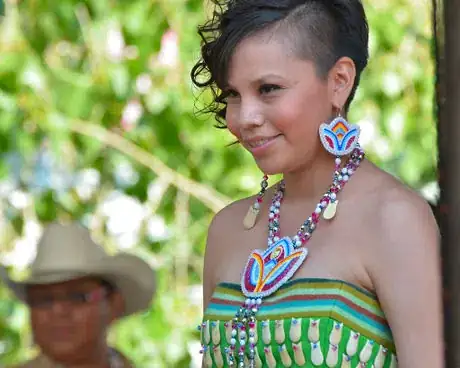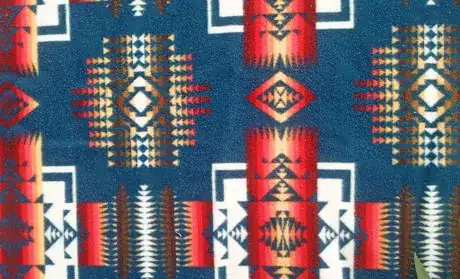wikiHow is a “wiki,” similar to Wikipedia, which means that many of our articles are co-written by multiple authors. To create this article, 45 people, some anonymous, worked to edit and improve it over time.
There are 10 references cited in this article, which can be found at the bottom of the page.
This article has been viewed 91,619 times.
Learn more...
Beautiful patterns, fabrics and symbols inspired by Native American art and designs appear everywhere from Paris fashion runways to chain retail stores. If you want to wear moccasins, beaded jewelry and other clothes or accessories with Native American roots, it's important to understand the history of these items and show respect for those who created them. See Step 1 to learn ways to add Native American designs to your look in a way that celebrates native cultures while respecting their tradition and history.
Steps
Choosing Clothes and Accessories
-
1Look for clothes and jewelry made by Native American designers and artists. Buying clothes and jewelry made and directly sold by people you've actually met or talked to ensures that credit is given where it’s due. Artists from many different Native American cultures sell beautiful clothes, jewelry and other accessories. Check online for Native American retailers[1] or shop locally for more options.
- This way you can also get a better understanding of the historical and cultural significance of the items you wear. For example, if you buy a piece of jewelry directly from the person who made it, you can ask him or her to tell you more about what’s behind the design.
- Making sure Native American artists and designers are in control of the sales of their own goods is really important. When Native American symbols and designs get manufactured and sold out of context, their significance gets lost, and that's detrimental to the individual cultures responsible for these highly sought after items.
-
2Look for items that are labeled “Native Made” or “Indian made.” The Indian Arts and Crafts Act protects items that were native made, and only these authentic items are allowed to have this label.[2] If the label says it was made somewhere across the world, it’s probably not an authentic item, and Native American designers and artisans won’t benefit from its purchase.[3]Advertisement
-
3Research brands to find out their history. If there's a brand making a Native American-inspired item that catches your eye, do some research to see how it's being manufactured and what the company's business practices are. Even if the company isn't Native-American owned, its owners might be using practices that you can get behind. See if you can find out the following:
- Does the company credit the artist or group of people who originally inspired the design or product they're selling? Do they get the proceeds?
- Does the product perpetuate Native American stereotypes of any kind, or does its design and manufacture honor the spirit in which it was created?
-
4Skip the mass-produced imitation items. Since Native American-inspired designs have become so popular, it’s easy to find mass-produced “Native American” products in every mall. But these items aren’t authentic, and more importantly, the people who originally created the designs don’t benefit from their sales.
- Avoid fake versions of Native American items, like plastic headdresses or cheap imitations of animal pendant jewelry, especially if they were factory made in a different country. These were not made by people who understand the cultural significance behind such items.[4]
- The same goes for traditional patterns and trademarks that some cultures hold sacred. For example, items like underwear and liquor flasks with Navajo-inspired prints don't honor Navajo culture.[5]
Having Cultural Awareness
-
1Think about the history of what you wear. Do you know the origin of that Cherokee-inspired pattern on the t-shirt you bought? If not, take the time to find out. If you wear something created by another culture and to which you have no personal connection, you might be committing a huge faux pas without even realizing it.
- Before you decide to wear something around, think about what it means, and conduct some research to dig deeper.[6] Whether it’s a pair of moccasins with the classic thunderbird beading, feather earrings or a sweater with a bold native-inspired design, it’s important to think about the history of clothes and jewelry that have Native American roots, so you can be respectful to those who created them.
- If you choose to wear something you do know has cultural significance without acknowledging it, that’s a form of cultural appropriation - taking something that’s not yours and pretending like it is.
-
2Understand that some items are probably best left to their inventors. Some items are fine to wear, but some might have sacred meaning or a history that makes them ill-advised to wear unless you're part of a particular tradition. In these cases it’s important to be willing to not wear something, even if you think it’s beautiful and have no intention to cause any harm.
- For example, feathers, headdresses and warbonnets have particular spiritual meaning. Some of these items must be earned and received through special ceremonies. Therefore, they are not to be worn casually by people unfamiliar with the cultures from which these practises stem.[7]
-
3Learn about Native American history.[8] Knowing more about the history of how Native American cultures have historically been oppressed in the US will help you understand why something as seemingly simple as wearing a piece of jewelry is actually very meaningful.[9] What you choose to wear can either be a celebration of a culture’s beauty or a sign of deep disrespect, and learning more will show you the difference.
Putting it Into Practice
-
1Don’t try to “look” Native American - unless you are. Trying to look as though you’re part of a culture other than your own is not a good idea. If you’re attracted to Native American designs and art, educate yourself about Native American history and learn how to honor Native American values without appropriating them.
- Even famous fashion designers, musicians, sports teams and movie stars are guilty of perpetuating stereotypes and crossing the line.[10] But many groups have spoken out against these practices and called on non-Native Americans to stop. For example, the “Change the Mascot” campaign calls on the National Football League to stop using an offensive mascot for the NFL team in Washington, DC.[11]
- Making your best effort to be well informed will help you express yourself through fashion without hurting other people.
-
2Wear a few special pieces instead of an entire outfit. If you dress “Native American” from head to toe but you don’t have Native American heritage, you’re making a statement that you’re someone you’re not. Wearing a pair of moccasins or some turquoise jewelry is a fine choice, but decking yourself out in every item you own at once is probably over the top - and a little too close to trying to “look” Native American.
-
3Don’t go out in a costume. Don’t dress up like a stereotypical version of a Native American for any reason - even if it’s for a costume party or Halloween. Even if you think it’s all in good fun, it’s disrespectful and ultimately harmful. You might mean well, but even if you’re dressing up as a favorite character from a book, show or movie, it’s still not OK to put on this type of costume. Your costume choice could be very offensive to some people.
Community Q&A
-
QuestionWhat race are Native Americans?
 Community Answer"Native American" is a racial category in and of itself, though some may choose a different label, i.e, American Indian, Indigenous, Native, First Nations, etc.
Community Answer"Native American" is a racial category in and of itself, though some may choose a different label, i.e, American Indian, Indigenous, Native, First Nations, etc. -
QuestionWhy do people think that Native Americans are all dark skinned long-hair wearing people?
 Community AnswerBecause some people have had few live encounters with modern-day Native Americans, so their perceptions are stuck in the past.
Community AnswerBecause some people have had few live encounters with modern-day Native Americans, so their perceptions are stuck in the past. -
QuestionI'm a Native American, and I want to start dressing with things from my culture, but I'm scared of encountering racists. How can I stop being afraid of dressing how I want?
 Community AnswerDon't focus on those people! Show pride in your ancestry. If anyone discriminates against you, hold your head high and remind yourself that your heritage is more important than their opinion. (If necessary, you always have legal options when it comes to discrimination.)
Community AnswerDon't focus on those people! Show pride in your ancestry. If anyone discriminates against you, hold your head high and remind yourself that your heritage is more important than their opinion. (If necessary, you always have legal options when it comes to discrimination.)
References
- ↑ http://www.beyondbuckskin.com/p/buy-native.html
- ↑ http://www.artnatam.com/law.html
- ↑ http://jdgriffithlaw.wordpress.com/2012/09/07/the-indian-arts-and-crafts-act-protecting-genuine-indian-made-arts-and-crafts/
- ↑ http://www.thebolditalic.com/articles/3393-please-dont-commodify-my-culture
- ↑ http://usatoday30.usatoday.com/money/industries/retail/story/2012-02-29/navajo-trademark-urban-outfitters/53299172/1
- ↑ http://www.thebolditalic.com/articles/3393-please-dont-commodify-my-culture
- ↑ http://nativeappropriations.com/2010/04/but-why-cant-i-wear-a-hipster-headdress.html
- ↑ http://www.loc.gov/teachers/classroommaterials/presentationsandactivities/presentations/immigration/native_american.html
- ↑ http://www.ncai.org/












-Step-13.webp)

-Step-5.webp)












































